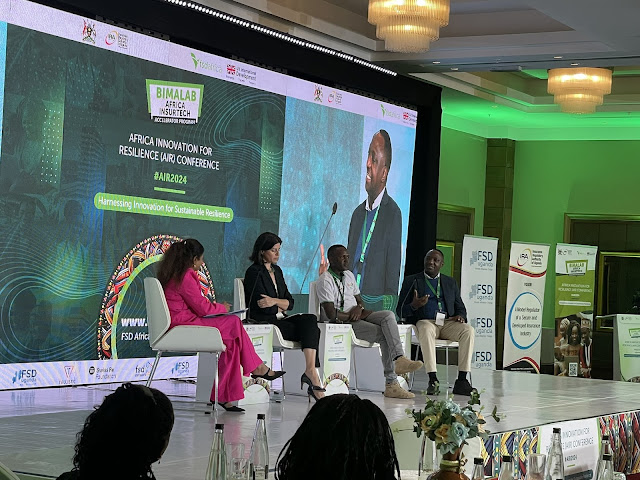𝗔 𝗖𝗹𝗼𝘀𝗲𝗿 𝗟𝗼𝗼𝗸 𝗮𝘁 𝗨𝗴𝗮𝗻𝗱𝗮’𝘀 𝗖𝗹𝗲𝗮𝗻 𝗘𝗻𝗲𝗿𝗴𝘆 𝗧𝗿𝗮𝗻𝘀𝗶𝘁𝗶𝗼𝗻 𝗦𝘁𝗮𝘁𝘂𝘀 𝗤𝘂𝗼 𝗮𝗻𝗱 𝗙𝘂𝘁𝘂𝗿𝗲 𝗢𝘂𝘁𝗹𝗼𝗼𝗸
Background:
Uganda's energy landscape is
undergoing a transformative shift, as the country seeks to transition towards a
more sustainable and clean energy-driven future. Despite its heavy reliance on
traditional energy sources, Uganda's Energy Transition Plan (ETP) has set
ambitious goals to enhance the adoption and utilization of clean energy
technologies.
In an in-depth interview, we spoke with Michael Ahimbisibwe, Program Manager (REAP/REAL) at ADRA Uganda with extensive experience in water supply systems, renewable energy, WASH, humanitarian action, and refugee settings, to gain insights into the current status quo, key challenges, and the future outlook for clean energy in Uganda.
Interview Questions:
1. In your own
opinion, what does the current share of clean energy in Uganda's overall energy
mix look like?
I believe that Uganda's current
share of clean energy in the overall energy mix is growing but still modest.
Hydropower dominates, contributing a significant portion of our energy, solar is
taken great milestones from lighting application to now heating and small
extent of cooking but medium to large scale projects have been implemented in
Uganda with a significant number of solar villages across the country. Other
renewable sources are gradually increasing their share like bioethanol that is
being optimized by different sugar companies is growing its production,
biodiesel is still at small scale being tested for farm equipment in research
institutions, Biogas has spread drastically at household level using livestock
feedstock and many rural homesteads are using it for lighting, heating and
cooking.
2. What are the
primary clean energy sources being utilized, and what is their current capacity
in supporting a just transition - trilemma?
The primary clean energy sources
in Uganda are hydropower, solar, and biomass (biogas, bioethanol, biodiesel).
Hydropower remains the largest contributor with several large dams operational,
while solar energy is increasingly being adopted, especially in off-grid and
rural areas. Biomass, although used extensively, needs to transition towards
more sustainable and efficient methods. Hydropower current capacity is
approximately 1,200 MW (Bujagali 250 MW, Karuma: 600 MW (expected completion
soon), Isimba: 183 MW). Solar current capacity is approximately 50 MW (Soroti
Solar Power Station: 10 MW, Tororo Solar Power Station: 10 MW and Kaiso-Tonya
Solar Plant: 10 MW). Geothermal is currently under development, with an
estimated potential of 450 MW but no significant operational capacity yet in
the projects of Katwe-Kikorongo Geothermal Project at exploration and
feasibility studies ongoing and Buranga Geothermal Project at exploration phase.
For case of biomass the current capacity is approximately 100 MW excluding the
domestic consumption, Projects like Kakira Sugar Works (Cogeneration using
bagasse) at 50 MW, Kinyara Sugar Works (Cogeneration using bagasse) at 40 MW
and Biomass Gasification Projects where various small-scale projects
contributing to the remaining capacity. These sources are critical in
addressing the trilemma of energy security, environmental sustainability, and
social equity, but the capacity for a just transition requires significant
enhancement and investment.
3. What are the
key challenges and barriers that have hindered the widespread adoption of clean
energy in Uganda?
The key challenges include
limited infrastructure, high initial capital costs, insufficient funding, and a
lack of awareness and education about clean energy benefits. Additionally,
regulatory and bureaucratic hurdles can slow down the implementation of clean
energy projects. In rural areas, the lack of grid connectivity and maintenance
issues further hinder adoption.
4. What policies,
incentives, and regulatory frameworks are in place to support the deployment
and utilization of clean energy technologies?
Uganda has implemented several
policies and frameworks to support clean energy, including the Renewable Energy
Policy, Feed-in Tariff Policy, and the Uganda Energy Credit Capitalization
Company (UECCC). These aim to provide financial incentives, support public-private
partnerships, and reduce barriers to entry for renewable energy projects.
However, there is a need for more comprehensive and supportive regulatory
frameworks to fully realize the potential of clean energy.
5. What are the
key emerging clean energy technologies and innovations that hold the most
promise for Uganda's energy landscape?
Emerging technologies such as
off-grid solar power systems, improved biomass cookstoves, and mini-grid
solutions hold significant promise. Innovations in energy storage and grid
management can also enhance the reliability and efficiency of renewable energy
sources. Additionally, advancements in wind energy and geothermal power could
diversify Uganda’s clean energy portfolio.
6. What are the
potential socio-economic and environmental benefits that a successful clean
energy transition can bring to Uganda?
A successful clean energy
transition can bring numerous socio-economic benefits, including job creation,
improved public health, and enhanced energy security. Environmentally, it can
lead to reduced greenhouse gas emissions, less deforestation, and more sustainable
natural resource management. It also promotes social equity by providing
affordable and reliable energy access to underserved communities.
7. In your own
judgement, what will Uganda’s energy sector look like in the next 10 or so
years?
In the next decade, I envision
Uganda’s energy sector becoming more diversified and sustainable, with a
substantial increase in the share of renewable energy. With continued
investments and supportive policies, we can expect to see expanded solar, wind,
and possibly geothermal energy projects. The integration of advanced
technologies and increased public-private partnerships will drive this growth,
leading to improved energy access, economic development, and environmental
sustainability.
.jpg)




Comments
Post a Comment